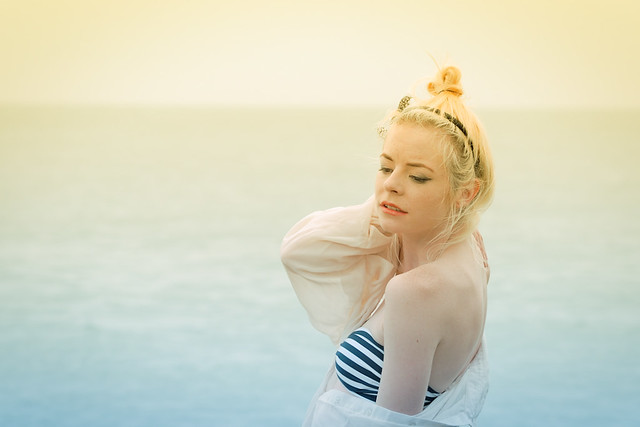Lighting is one of the principal elements in portraiture. In order to produce quality photos it’s essential that you understand the very basics. An important aspect that you have to keep in mind is the direction of light.
I would like to differentiate the types of light that a photographer can work with when shooting portraits. As a novice, usually you can work with two principal types of light. On the contrary, as you gets more experienced it comes as second nature to introduce more types of light for various effects.

Photo by Teymur Madjderey; ISO 200, f/2, 1/200 exposure.
The Modeling Light
This is the main light that will illuminate the features of the model. Photos produced by this light are high in contrast and very dramatic. Usually this type of light is set at a 45 degrees angle from the line of camera to model.
If you’re working with a natural source, such as sunlight or moonlight, a side window can be your main light. Ideally you pose your model at an angle to the window. To avoid direct, strong sunlight make use of a white translucent curtain so that the harsh glow is diffused nicely.
The Fill-In Light
To complement the modeling light, a second type of illumination is needed. The fill-in light’s main use is to lighten up the harsh shadows created by the modeling light. This usually has half the power of the main source. Commonly it can be achieved either by moving the light away from the model or reducing its power by half. Most of the time this type of light is set close to the camera.

Photo by Kurt Budiarto. A wirelessly-triggered flash with a silver umbrella was used for fill light.
Again, if you’re using a side window as your source, your fill-in is light reflected from practically any type of reflective surface, as long as luminance is bounced back effectively. This way you light up the dark shadows on your model’s face.
Effects Lights
There are three basic types of effects lights to work with:
Background Light. This light in the background defines the shape of the model. Also it brings out details in the backdrop.
Top Light. The main use of the top light is to highlight the hair, giving it body and shape.
Back Light. In order to obtain a rim-light on the face, head, and shoulders, normally a back-light is placed behind the model. This must not be confused with the background light, where its main purpose it to light the backdrop. This is also possible when you have sunlight behind your model. Using this kind of back light wisely, the results can be amazing.
Understanding more about the directions of light and applying them to your work by experimenting and try out new ideas, you can easily produce more creative photographic work.
Next time you’re posing and directing models, make sure that you also direct light intelligently to your advantage.
About the Author:
Written by Michael Abela. Do you want to acquire a handful of posing secrets so that you too can master the art of posing and directing a model? If yes, take action and follow my site at http://michaelabela.weebly.com in order to manage to move from one style to another with ease like a pro.
Like This Article?
Don't Miss The Next One!
Join over 100,000 photographers of all experience levels who receive our free photography tips and articles to stay current:






Good basic article, thank you! However, I always heard the term “modeling light” refer to the light that was used when setting up the shot, to help visualize where the light was hitting the model. This light is then turned off when the real shooting begins. I think the term more often used instead of “modeling light”, like how you are referring to it, is “key light” or as you do say at one point, the “main light”. Thanks again for the great articles, love PictureCorrect! :)